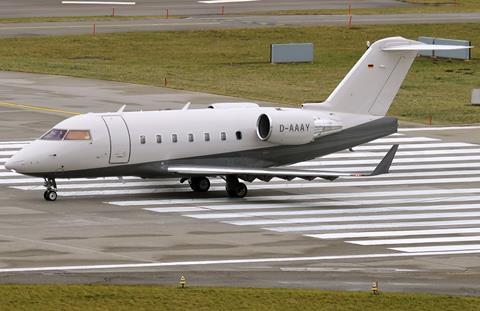UK investigators have disagreed with Bombardier over the cause of a Challenger 604’s uncommanded – and unarrested – full flap extension at high speed, during a climb out of Farnborough.
Bombardier had classified such an event as potentially catastrophic during certification, but the original safety case for the aircraft considered it extremely improbable as it required two concurrent failures, in the flap drive and the flap-arrest system.
The aircraft’s flap surfaces are moved by two drive motors which use four extend-and-retract relays. These relays also form part of the arresting system to stop uncommanded movement.
After the Challenger departed Farnborough for Malaga on 10 August 2022, its flaps were retracted from their 20° take-off position. But they only moved at half their normal retraction speed.
As the aircraft climbed through 19,000ft, travelling at 305kt, the flaps began to extend, reaching 45° with the jet still flying at 234kt.
Analysis by the UK Air Accidents Investigation Branch has been unable to identify the reason for the uncommanded flap extension.
The inquiry ruled out an erroneous flap-lever command and a fault in the electrical wiring to the flap-extension relays.
It also considered scenarios involving a possible internal fault in the flap-control unit or the flap-position sensor in the power drive unit. None was found but investigators could not discount the possibility that they were unable to replicate a previous failure.

Bombardier derived its own probable scenario for the uncommanded flap movement, after examining three occurrences involving a second Challenger 604 in March-April 2023.
The airframer concluded that “wear and backlash” in the flap operating system was sufficient for the flaps to creep, under airframe vibration, while the engines were running.
When this movement reached 3° it caused the flap-protection system to operate, and a dormant failure in a flap relay then caused the flaps to fully extend at half-speed.
But while Bombardier believes this is the “most likely” explanation for the Farnborough incident, the Air Accidents Investigation Branch considers it “unlikely”.
While the scenario “cannot be discounted”, the inquiry says, the flight-data recorder information from the Farnborough aircraft did not show any evidence of flap creep during the event, or during 64 previous flights.
Those 64 flights at least, the inquiry found, had taken place with a latent failure in one of the flap retract relays – caused by welding of contacts, triggered by unsuppressed back-EMF arcing – which led to the half-speed retraction issue on the aircraft, and also caused the failure to arrest the uncommanded flap extension.
The original safety case for the aircraft assumed such a latent relay failure would not go undetected for more than one flight.
But the Farnborough incident inquiry turned up three different aircraft on which a failed relay had remained unnoticed for a “significant number of flights”, despite the half-speed movement of the flaps.
Operators of the jet have since been instructed to conduct regular checks on the flap system, but Bombardier has resisted the recommendation to establishing a life policy for the affected relays, describing it as an “undue burden” that is “unjustified”.
Bombardier has, however, committed to introducing mitigating corrective actions by the end of June this year, and is also developing a design change to the Challenger flaps system, which will cover the 604, 605 and 650 models by the end of February 2025 and the 600 and 601 by the end of November 2025.


























